August 21 (Fri), 2009
#3 Diane Orrett
Rakugo performer/Balloon artist
(She's been in Japan since 1990)
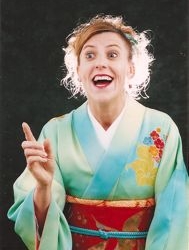
Laughter is international.
My Eyes Tokyo flew to Osaka, the Japanese capital of comedy again!
We've had interviews with two foreign entertainers in Osaka in early 2008. Then we found a new foreign performer there recently.
Diane Orrett, a British woman who performs a Japanese traditional comic story telling called "rakugo(落語)". She performs rakugo in both Japanese and English. Also she works as a balloon artist who makes animals, cartoon characters and so on.
We talked to her over the phone before we went to Osaka and we were impressed by her cheerfulness and politeness. We felt sure that an interview would all work out. And it did!
She laughed a lot and we also laughed a lot during our interview. We thought she was a born entertainer. As her stage name "Diane Kichijitsu" (This name originates from a Japanese word "Taian-kichijitsu", which means "Lucky Day") suggests, she loves to entertain people and loves to make them happy with all of her heart. She is a vibrant flower in such a cold world.
*Interview @ Patisserie "LEAI" (Tanimachi, Osaka)
Kansai Interviews;
#1 Spence Zaorski... Click here to read.
#2 Mizirakli Halit... Click here to read.
Traditional entertainment is still powerful.
Japanese rakugo has a formal style. In rakugo, performers are kneeling down on a cushion but can give very active performances. We can be walking, running or flying from the same position. One performer plays all of the characters but without any costume changes. We have only two props, a sensu (扇子; folding fan) and tenugui (手ぬぐい; facecloth). I think it's a very original style of storytelling. It's very interesting.
Rakugo has a 350 year-history but I think it's still very powerful and doesn't age. It still makes people laugh.
I think it's a good way to teach people about Japan and a good way to teach Japanese people about life overseas. It’s suitable for any age group.
Also I like to create things because I'm an artist. I used to be a graphic designer when I was in England.
Creating stories, creating an idea, creating characters. It's all based on imagination. The world of rakugo is the world of imagination. It's up to the performer to create the scene in everybody's head.
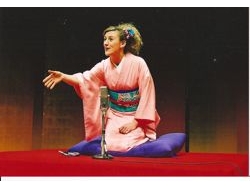
Odyssey from the Beatles' hometown.
I came here in 1990 from Bangkok. Before that, I had been traveling around the world. I've been to 38 countries so far. After leaving Liverpool, England in 1988, I visited countries and areas such as Canada, Hawaii, Australia, New Zealand, Singapore, Malaysia, and Thailand before arriving in Japan.
Since childhood, I'd always been interested in foreign countries. When people went traveling, they bought me dolls. And I had a collection of dolls from different countries with their national costumes on. I always read books about different countries and I used to dream about going to those countries someday. I used to imagine what kind of lifestyle and childhood those people had. I just always imagined myself traveling. I decided when I was about three years old that I wanted to go to abroad.
Similarity between Liverpool and Osaka.
When I was in New Zealand, I met a woman from San Francisco who had lived in Japan for one year. I met her again in Thailand and we talked about Japan.
She advised me to come here. She suggested coming to Osaka first because she had lived here. So I flew directly to Osaka from Bangkok. I think now that she kind of pushed me in the right direction.
I think Osaka is pretty similar to Liverpool, my hometown. Everybody likes to laugh. Everybody seems to have a sense of humor. Here in my local neighborhood, everybody is so nice and friendly.
Something kept me here in Japan. I was very interested in arts and traditional things. I was attracted to the culture, especially kimono designs. I think that kimono is not just an item of clothing. I think it's art, something of beauty.
Encounter with rakugo.
A friend of mine was an English teacher of "Katsura Shijaku", a professional rakugo performer. My friend called me and said, "My student performs rakugo in English and he's looking for a foreigner to be the ochako." "Ochako (お茶子)" means a stage assistant who is in charge of things such as turning over the cushion between performers. I didn't know anything about the rakugo world so I was going to say ”No”. But he said, "They will dress you in a kimono." Straight away I said, "OK, I'll do it!".
I decided to be his ochako because I loved wearing kimonos. Any chance that I had to wear a kimono was exciting for me.
My debut as his stage assistant was in 1996. I didn't know what rakugo was until that first night. Rakugo is deep and my Japanese wasn't good enough to understand it then. I watched Shijaku's performances a few times because I was his ochako. I've always liked animated performances, mime, and storytelling.
I was shy when I was a child. But I realized that I wanted to become a rakugo performer even though I would sometimes have to perform in front of five hundred or more people. That’s something that, as a child, I would never have been able to believe. I was able to overcome my shyness because I had a passion for performing. My passion for doing it was stronger than my fear.
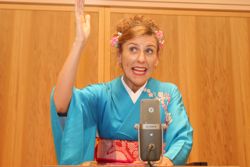
Debut as a rakugo performer.
I joined a rakugo dojo (道場; training hall) and studied the basics, eye direction, intonation, how to play different characters, how to use the props, how to move and so on.
Then I did my first performance. I really enjoyed it. I just got more and more interested and I started to write my own stories.
My very first performance was in Japanese. I wrote an original rakugo story in Japanese. It was called "Kacho (課長; A Division Chief)", a story about a Japanese businessman and portrayed the hierarchical relationship which is unique to Japanese society. Everybody has to do everything that he says even if they don't agree with him, because he is the division chief... It was about a situation that I had seen in Japan so many times.
Things we can learn through rakugo.
After that, I started to perform in English. I like to write about my own experiences in Japan because it makes Japanese people laugh and foreigners think, "Oh, that happened to me too!" People watch the story and laugh, but they also learn. "Oh, my God! I always do that when I meet a foreigner." "I suddenly realized that foreigners always get asked the same questions".
Rakugo is a good way of getting a message across about cultural differences. If I do a story about a Japanese person who goes overseas then there are experiences can help people to learn.
Also, I can learn about old Japan by watching koten-rakugo stories (古典落語; old, classic tales). I didn't know how people used to live. We can learn a lot about culture, language and history through a story.
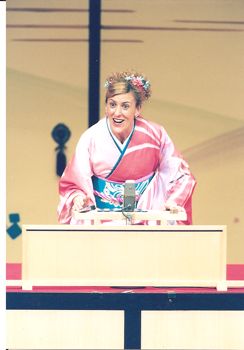

Not only is Diane a rakugo performer but she is a balloon artist.
She really loves to entertain people and loves to make them happy!
Rakugo crosses any borders.
I've performed in England a couple of times and America and Australia. Each country has it’s own blend of humor. People have a different sense of humor so you have to find a point that everybody can relate to. Hopefully then we can make people laugh. In one country something may be considered funny but it might be offensive in another country. That's something you have to learn.
Laughter is international. Even as babies we have the ability to laugh. We all enjoy a good laugh when we find something funny.
Each story is a new challenge. When performing for foreigners who have never been to Japan, it’s up to the performer has to help them to be able to visualize the traditional lifestyle of old Japan. In many cases, the audiences don't know even about modern Japan so how can they visualize old Japan? The storyteller needs to understand the lifestyle in Japan a hundred years ago? That's a big challenge.
Young Japanese people also don't have much experience of the old, traditional side of Japan. So when I perform rakugo for Japanese kids, they often don't even know what rakugo is. I like to give them a little demonstration of what rakugo is so that they can enjoy it.
I would like to perform overseas more often to try to introduce Japanese culture. Not only rakugo, but other traditional aspects of Japan too. I’d like to share my own personal memories, impressions and daily experiences with people.
A role I play in the Japanese entertainment world.
I think I'm in a really good position because performing in English as a foreigner is still something relatively new. People are curious, "I wonder what English rakugo is" or "I wonder what kind of rakugo a foreigner does" so they come to an English rakugo show.
A lot of kids write on the questionnaire papers, "Today was the first time I've been to see rakugo". So for them, their first experience of rakugo was in English, performed by a foreigner. If they’ve enjoyed the show, they often want to go to watch a performance in Japanese. I think that people just need to find an opening.
I think that a lot of people here don't realize that people around the world are very curious about Japan. If you tell Japanese high school kids that children in England think Japan is cool, suddenly they appreciate and are proud of their own culture.
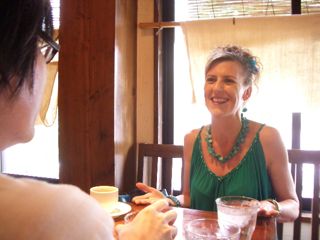 *Photo by Akiko Kawane
*Photo by Akiko Kawane
What is rakugo to you?
I think it is a "vehicle" for many things,
telling stories, sharing humor, learning about language and culture, giving information, educating people, making people laugh.
We can all learn a lot through rakugo.
What is Japan to you?
Japan is where I found myself.
I’ve faced a lot of challenges, good and bad experiences, and I've learned
a lot about myself here. I think I actually grew up in Japan.
It’s probably where I was born again.
Diane's Links
Her website (Japanese): http://www.diane-o.com/
Diane on the radio! (April 30, 2011): Click!
Diane Orrett interview by EnglishStarJapan:
http://www.youtube.com/watch?v=zCOetjUZvFk
http://www.youtube.com/watch?v=liuW8ITNYJk

 Previous
Previous